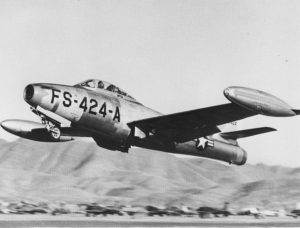
Looking Back – 1950
Jet Explodes Over Emmitsburg
by James Rada, Jr.
On the evening of August 30, 1950, a thunderstorm rolled into the area, but above the rumbling of thunder, many people heard something else.
John Hilbert’s farm was 2.5 miles northeast of Emmitsburg, along what is now MD 140. His wife heard the wind whipping up around 9:30 p.m. and went to the door of her home to close it; however, before she got there, she heard a loud roar. “I thought lightning had hit the house, and went upstairs to get the children up,” she told the Gettysburg Times. “When we went outside, we found the house all right, but three fires were burning in the corn field, and there were sparks all over the place.” On another nearby farm, Lloyd Leatherman heard a loud noise that shook his house. “I ran out and saw the plane explode,” Leatherman said. “I thought the explosion was closer to my home than it was.” He said that the plane was about tree height when he saw it going down. He ran to his neighbor’s farm. Carrol Prock had a phone, and Leatherman used it to call the Pennsylvania State Police, because he believed that the plane had gone down in Adams County. Prock had also seen the plane explode. He told the Gettysburg Times that it looked like “a haystack on fire in the air.” Hilbert called the Maryland State Police to report the crash, and his farm was soon swarming with state troopers from both Maryland and Pennsylvania, as well as volunteers from the Barlow Fire Department, Frederick County sheriff’s deputies, volunteers from the Gettysburg Fire Department, and volunteers with the Emmitsburg VFW ambulance. They started a search for the pilot and passengers. Unfortunately, they only found pieces. The largest piece of the pilot found, according to the newspaper, was the pilot’s left hand and wrist, which was still in a glove. Soon, airmen from Andrews Air Force Base in Washington joined the search. It was learned that the plane had been an F-84 Republic Thunderbolt that had crashed, along with its pilot, twenty-two-year-old Michael Alkire of Washington, D.C. He had been a 2nd lieutenant with the Air National Guard and a member of the 121st Fighter Squadron, based at Andrews. F-84s were the primary attack jets used during the Korean War. They flew 86,408 missions and destroyed 60 percent of all ground targets in the war. While early versions of the jet had structural problems, by 1950, the Thunderbolt was a dependable aircraft. Alkire had recently completed jet fighter training school and was flying on the wing of his element leader, 1st Lt. William Hall. They had been on a training flight that had taken them up to Indiantown Gap in Pennsylvania. They were on their way back and trying to avoid the storm by climbing higher into a cloud formation. The Hagerstown Mail reported that when Hall “came out of the cloud, he could not find Alkire’s plane.” It was not Alkire’s first crash that year. At the end of June, Alkire’s F-84 had crashed against a river dyke at the end of the Olmsted Air Base runway. In that incident, he either ran out of fuel or had a “flame out,” according to the UPI report. He walked away from that crash with only minor injuries. Volunteers searched the Hilbert’s 10-acre cornfield, which was illuminated with flood lights. Debris was found scattered over a half mile. Bernard Miller from Gettysburg was one of the searchers. He said that when the search ended at 2:30 a.m., they had found “enough of the pilot to fill a bushel basket and almost enough of the plane to fill a pick-up truck.” The largest pieces of the plane were only eight to ten inches in length.
Fighter-Bomber Squadron in Korea.
